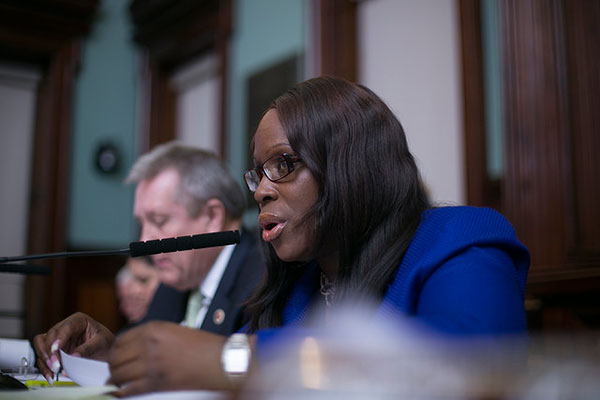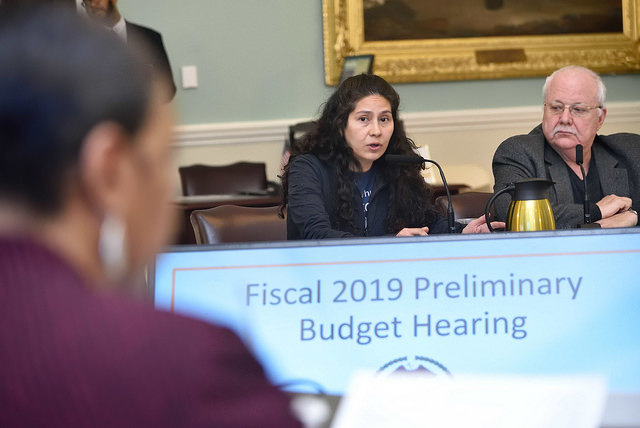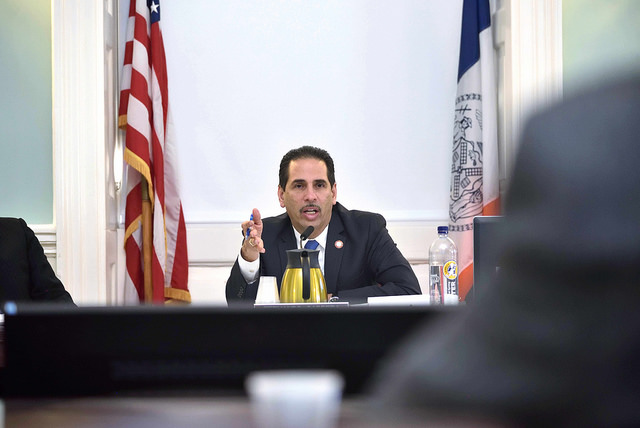City Council Begins New Focus on Capital Budget, with Eye Toward Transparency

Council Member Gibson (photo: William Alatriste)
As the New York City Council continues to examine Mayor Bill de Blasio’s $88.67 billion preliminary budget for 2019, a newly created committee under Council Speaker Corey Johnson is paying extra attention to the ‘other’ budget - the capital plan - the administration’s proposed spending on schools, parks, jails and other long-term infrastructure projects.
Over the last few weeks, the new Subcommittee on the Capital Budget chaired by Council Member Vanessa Gibson, under the purview of the Committee on Finance, has been conducting oversight of agency-specific capital spending and, on Tuesday, the committee turned its eyes to the administration’s overall $45.9 billion preliminary capital budget for 2019-2022.
That capital budget proposes authorizing $11 billion in new spending for the 2019 fiscal year alone. The city’s fiscal year begins July 1.
Separate from the proposed capital budget is the capital commitment plan. While the budget is set aside for all capital needs not previously allocated, the commitment plan accounts for the money the city actually intends on spending on capital projects in sum. At Tuesday’s hearing, Council Members analyzed the $79.6 billion capital commitment plan for 2018-2022, including $19.3 billion that would be spent for fiscal year 2019 (including funds rolled over from previous years).
“For too long, the majority of our attention, the public’s attention, and the advocates’ attentions has been on the expense portion of the budget,” said Speaker Johnson, in his opening statement at the hearing, referring to the city’s annual spending on operations, typically simply referenced as the city budget. “This has left mayoral administration after administration to manage the capital budget process largely without the rigorous review it deserves,” Johnson said, giving indication to why he created the new subcommittee. This is the first budget process since Johnson was elected speaker by his 50 Council colleagues.
Johnson, and several of his colleagues after him, criticized successive administrations for allocating a majority of funds in the early phases of years-long projects, rolling over unused funds, and lumping in dozens, if not hundreds, of projects under broad budget lines.
Gibson pointed out the glaring discrepancy between how much the city was appropriating for capital projects and how much was being spent each year. “This is certainly not a new phenomenon, this is not a new concept,” Gibson said, noting that between fiscal years 2012-2017, the city had on average appropriated $36.7 billion annually, planned to spend $15.3 billion on average, and spent only $8.5 billion.
“As always, we will approach the capital budget process with caution,” said Melanie Hartzog, director of the Office of Management and Budget, in her opening remarks Tuesday, emphasizing that the city was being careful about its spending on debt from infrastructure projects. Hartzog, recently promoted to the position by de Blasio, noted in her testimony before the Council the impact of the federal and state budgets on New York City, including proposed cost shifts for MTA capital to the city -- a proposal from Governor Andrew Cuomo that is being debated in Albany -- and the devaluing of a federal tax credit that incentivizes the creation of affordable housing. She also reiterated many of the new and ongoing investments made by the administration in traffic safety, flood mitigation, transit infrastructure, schools, affordable housing, economic development and public housing.
Hartzog said the administration has taken steps to provide more accurate assessments of capital needs, by investing at least $50 million for agencies to plan and review projects before funding is put toward them. The administration has also increased staffing at agencies with large capital needs to focus on project planning and management, she said.
A key factor in possibly speeding up capital projects, Hartzog said, is design-build, a streamlined process that would allow the city to solicit combined design and construction bids for infrastructure projects. To use design-build, the city requires approval from the state, where passage has been elusive thus far, though there is the possibility this year of authorization for specific projects. It’s one of many key issues that the de Blasio administration has been pushing in Albany as Cuomo and the state Legislature negotiate the state budget.
“Applying the design-build approach would shave hundreds of millions of dollars from the cost of projects and reduce completion times by 18 months on average,” Hartzog said at the hearing. The city wants design-build for projects like rebuilding a portion of the Brooklyn-Queens Expressway, major NYCHA repairs, and building out jail capacity to replace Rikers Island facilities, among others.
The hearing was by-and-large amicable and Hartzog repeatedly promised to work with the Council on improving its capital process, having ongoing discussions with Council Members about proposed projects in their communities and conducting more regular reviews of capital spending. But the Council could not extract concrete commitments on reforms they hoped to see.
Johnson pushed for a 15 percent cap on the difference between excess appropriated funds and the capital commitment plan, using an industry-standard ratio for budgeting capital projects. “Basically, the Council is annually presented with a capital budget to adopt that gives twice the authority to spend over what is planned...It’s my opinion that it is time for a new status quo,” he said.
Hartzog, however, said the administration has increased the level of spending in the commitment plan “significantly” and reiterated that they are working to “rightsize” agency-specific capital plans. She noted that the 15 percent contingency funding applies to projects and cannot be used as a standard for appropriations. OMB Deputy Director Charles Brisky also emphasized that contingency funding allows needed flexibility for projects and that examining the difference between appropriations and commitments could be misleading.
“If you think that there’s more to be done, we’re open to working with you and your staff to get that done,” Hartzog added.
Council Member Daniel Dromm, chair of the finance committee, focused his attention on how the city plans to raise funds for capital projects, and the debt it incurs in the process. He noted that though the city’s borrowing has largely hewed close to expectations, the administration continues to overestimate the debt it will incur down the line.
“This overestimation skews the picture of the city’s debt affordability over the plan and provides the administration a convenient source of savings for subsequent citywide savings plans,” Dromm said in his opening statement, referring to the administration’s voluntary savings program for city agencies, which the Council has criticized for an inadequate focus on creating actual efficiencies.
Hartzog pushed back, calling it a “little bit of an apples-to-oranges comparison.” Her colleague, Brisky, explained that city borrowing was for projects that are years into construction or had already been completed, while the commitments were for future projects. “That’s a little bit harder to project,” he said.
When Gibson pushed for more detail on individual capital projects, yet again the budget officials demurred. “Are you willing to commit with us to looking at...how we can itemize some of those budget lines to look at specific projects and delineate a little bit of the large, overly-broad general budget lines the Council has typically received?” Gibson asked.
Hartzog agreed, but added, “I will say that, and I’m sure you agree with me, what we don’t want to do is cause any delay in any projects getting done.” She cited the Department of Environmental Protection which has large pots of capital funding set aside for emergencies that are hard to predict.
Although fiscal monitors have generally praised the de Blasio administration’s handling of the city’s finances, the Council’s criticism tracks with reports by independent watchdogs that the city’s capital planning needs to be more efficient.
“Rightsizing and right timing the capital plan is necessary for a more effective and more transparent capital planning process,” stated a recent report by Citizens Budget Commission. “Reducing planned commitments in the early years of the plan to a more attainable level would require the City to clearly articulate its capital priorities and immediate needs. It would also facilitate improved tracking of capital projects and allow for more accurate projections of City borrowing.”
[Read: Under 'Threat' from D.C. and Albany, De Blasio Presents $88.67 Billion Preliminary Budget]
***
by Samar Khurshid, senior reporter, Gotham Gazette
@samarkhurshid @GothamGazette
Community Board Reps Tell City Council They Need More Funding

Council budget hearing (photo: John McCarten)
Community boards need more money. That was the overarching message provided to the City Council’s Governmental Operations Committee by two district managers for Manhattan community boards at a preliminary budget hearing on Monday.
The mayor’s $88.7 billion preliminary budget for fiscal year 2019, which begins July 1 of this year, outlines $17.4 million in total funding for all 59 community boards, which are local panels of community members appointed by the borough presidents and serving in unpaid and largely advisory capacities to improve their neighborhoods. The responsibilities do not carry the weight of a binding vote, but do carry an influential advisory opinion on matters ranging from land use, budgeting, and liquor licenses.
Each board receives around $234,000 in “base allocation” for operating costs, as well as a variable amount in rent depending on space requirements and location. The district managers -- full-time community board employees -- argue that this is not nearly enough.
“We ask the Council to consider an increase in the annual budget of community boards,” said Angel Mescain, district manager of Manhattan Community Board 11 in East Harlem, in testimony to the committee, “to support the vital role they play in planning and quality of life advocacy for their communities.”
Community boards are perpetually understaffed, many argue, as they attempt to consider major issues and decisions facing their communities. The 51 elected City Council members typically have sizable taxpayer-funded staffs that can help members navigate the city’s dense bureaucracy and serve constituents. On the other hand, Mescain noted that his community board has enough resources for three full-time staffers and one part-time staffer. Lucian Reynolds, the district manager for Manhattan Community Board 1 in Lower Manhattan, gave a similar prognosis.
Reynolds, who joined CB1 in February after working for Manhattan Borough President Gale Brewer, said that the understaffing leads to issues not receiving their due time and consideration, with problems going unresolved or being inadequately resolved as a result.
“Community boards must decide whether they wish to narrow the roles of office staff towards land use and policy as CB1 has done over the years,” he said, “or to instead focus on constituent services as many other boards must do.”
As largely local advisory councils, community boards closely study issues and consider challenges and opportunities in neighborhoods. Without experts on staff, they also often rely on borough president offices, the City Planning Commission, and the local City Council member. The boards often try to influence those very officials and entities as well, attempting to reach community consensus on contentious issues. Community boards across the city vary in terms of their activity, acumne, and approach to local issues like development, bike lanes, and more; and the interest of local residents in serving on them also varies widely. Community boards are often derided as being packed with "NIMBYs" or people who always say "not in my backyard" to things like taller buildings and homeless shelters, or even integration of schools. Approaches vary widely.
But the boards say they face perpetual staffing shortages and a lack of funds for basic amenities offered to other levels of government, such as technical support around live-streaming meetings and putting information out on social media.
The Council members present at the hearing for the community board panel -- Fernando Cabrera, Kalman Yeger, and Adrienne Adams -- have all served on community boards and heaped praise upon them, stating that they intended to secure greater funding.
“The amount of work that communities do is the best investment we could make for the dollars that we invest in the city,” said Cabrera, the governmental operations committee chair and a former member of Bronx Community Board 7. “And it has a direct impact in our community.”
***
by Ben Brachfeld, Gotham Gazette
@GothamGazette
Civil Trials Commissioner Outlines Office’s Challenges

Council Member Cabrera (photo: John McCarten)
Amid a preliminary budget hearing where the City Council’s Committee on Governmental Operations heard testimony from several city agencies and other entities under its purview, representatives from the Office of Administrative Trials and Hearings, or OATH, did not ask for massive new resources, but explained the impact of an increased budget and an increased caseload, while also asking for more personnel.
The committee chair, Council Member Fernando Cabrera, leveled effusive praise towards OATH Commissioner Fidel Del Valle, whom he said had created a fairer and more objective OATH than had existed before the onset of the de Blasio administration.
“You do a superb job,” Cabrera said. “A superb job. You have taken your agency to a level of fairness and objectivity and impartiality like I have never seen of OATH before.”
Del Valle was appointed by Mayor Bill de Blasio as OATH commissioner and Chief Administrative Law Judge in October 2014. Since then, OATH’s budget has grown substantially, from approximately $31.3 million in Fiscal Year 2014 to approximately $48.9 million in the mayor’s proposed 2019 preliminary budget, which would represent an increase of 55%. A new city budget is due by the July 1 start to the fiscal year.
The number of OATH summonses has also increased significantly of late, from about 594,000 in 2013 to 844,000 last year. The reason for this growth is an expansion of OATH’s jurisdiction. OATH adjudicates summonses issued from 19 city agencies, from the Department of Buildings to the NYPD; in 2016, the Department of Consumer Affairs was added to OATH’s docket. Also in 2016, the City Council passed and Mayor Bill de Blasio signed the Criminal Justice Reform Act, which redirected summonses for many nonviolent, minor offenses such as public urination and public drinking from criminal court to OATH.
Of the 844,000 OATH summonses issued last year, 298,000 ended up in a hearing. The rest were either paid up front without a hearing, or were not responded to and resulted in a default ruling.
Being the agency with jurisdiction over noncriminal summonses, OATH collects far more in fines, amounting to $139 million, than the size of its budget. But Del Valle noted that, being a part of the office of the mayor, the funds collected through fees belong to the city and not to OATH.
“An entity such as ours cannot be connected with revenue generation,” Del Valle said, noting that once it became a concern, the agency could no longer be truly neutral in the cases it was adjudicating. “The role of justice is not to make money. The role is justice,” he said.
OATH has 315 full-time employees. However, many of the adjudicators in the hearings division, known as hearing officers, have day jobs as attorneys who are paid per diem to administer the hearings. Del Valle is requesting $123,000 in new funds for additional hearing officers.
“Frankly, hearing officers are not sitting around at home in their jammies waiting for me to give them a call saying ‘come on down, I’ve got more cases on the calendar today,’” Del Valle said. “They’re lawyers with their own calendars and their own court appearances. And they have to know well in advance of having to come in.”
Del Valle noted that a “squad” of permanent hearing officers would be ideal, but that OATH was not “getting that.” If there’s significant backlog, hearing officers often might not be able to render decisions immediately.
On average, Del Valle said that respondents receive a decision within 10 days.
The rate of summons dismissal varies significantly between agencies, largely dependent on whether the agency sends a prosecutor to the hearing. The lowest rate of dismissal comes from FDNY summonses, as the FDNY normally sends a prosecutor and the violations that receive summons are typically “deadly serious,” according to Del Valle. A similar situation exists with the Sanitation Department, which, according to The New York Times, accounts for nearly half of all the summonses OATH receives. Del Valle says that, despite the volume of Sanitation summonses, they do not put a strain on the agency as they can be routinely dismissed.
On the other hand, Del Valle says the agency with the highest rate of dismissal is the NYPD, where summonses are often more frivolous. The NYPD doesn’t typically send a prosecutor to OATH.
Del Valle also noted that a point of strain is summonses from the Department of Buildings.
“They all require the presence of a Buildings Department prosecutor and/or inspector to prosecute the summons,” Del Valle said. “And the strain comes from the fact that, based on what resources Buildings has, they make their summonses returnable basically one day a week in each borough.” He noted that, “on a particular Monday” at 8:30 a.m., the Brooklyn OATH office might see up to 800 Buildings Department summonses at once, leading to heavy strain.
***
by Ben Brachfeld, Gotham Gazette
@GothamGazette




